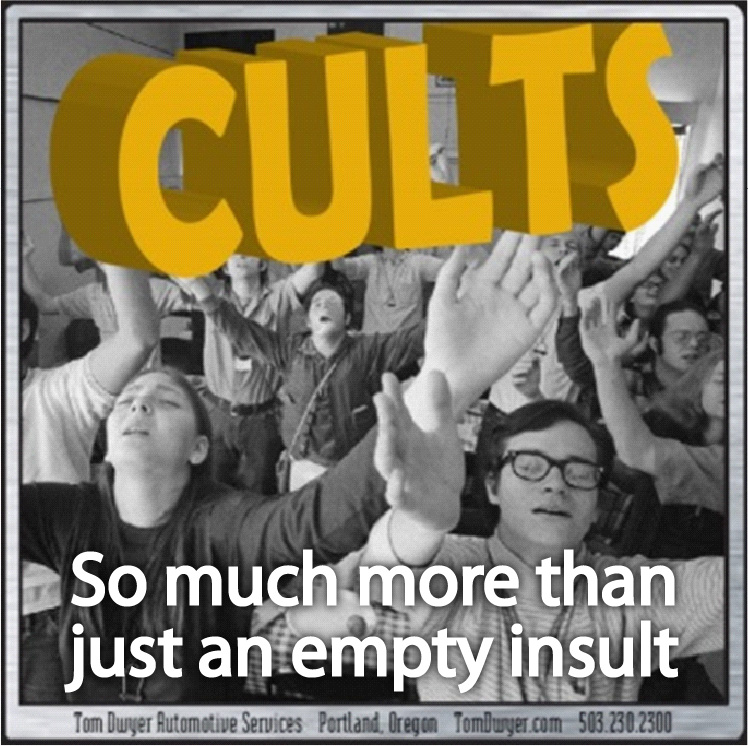 Cults are obviously real. Here’s how to deal with them.
Cults are obviously real. Here’s how to deal with them.
What’s the difference between a religion and a cult? The glib answer that “a cult is someone else’s religion” may have truth in it, but of course that’s not the whole story. It’s easy to see the ‘cult’ in groups we’re not a part of, but what about in our own? Cults exist on a spectrum with the defining features appearing in varying degrees in organizations from religion and politics to business and entertainment. They’re all different, but they all have at least one thing in common. None of the members ever realize they’re in a cult at all…
It’s a politically polarized time, and as various groups retreat into their increasingly insular corners the word ‘cult’ is thrown around all too casually. We worry that ‘Trumpism’, and QAnon particularly, are becoming dangerous cults that threaten America on many levels. But is that an unfair evaluation from the outside looking in? Couldn’t the same accusation be made against ‘Bidenism’ or BLM? The answer is ‘no’ for a variety of reasons, and we’re sharing this article to explain why. No one likes to think of themselves as being in a cult, but  some of us are wrong. ‘Cult’ isn’t just an insult; it’s a real and dangerous thing, and there are ways to know (or at least be suspicious) if cult techniques are in play.
some of us are wrong. ‘Cult’ isn’t just an insult; it’s a real and dangerous thing, and there are ways to know (or at least be suspicious) if cult techniques are in play.
One of the biggest voices in the world of Cults is Dr. Steven Hassan at the Freedom of Mind Resource Center. His BITE model (Behavior Control, Information Control, Thought Control, and Emotional Manipulation) has become one of the main yardsticks to identify cults. Like most phenomena, cults exist on a spectrum so there is not a definitive point when a group is ‘officially’ a cult. The BITE model gives guidance, and even the worst cults probably won’t meet every point. Importantly, the BITE model isn’t just about religion; it can be applied to any organization. We offer you Hassan’s complete BITE model, with several examples of application to the Mormon Church, Creationism, QAnon, Trotskyism, and Scientology. We’ll follow that with Cults in other areas, and though cults are notoriously difficult to fight, we’ll leave you with some information on how to fight back.
Hassan’s BITE Model
Steven Hassan’s BITE Model of Authoritarian Control, Freedom of Mind Resource Center
What is a Cult? Whiteboard Animation Explaining the BITE Model, Steven Hassan on Freedom of Mind, Nov 2018
Behavior Control
- Regulate individual’s physical reality
- Dictate where, how, and with whom the member lives and associates or isolates
- When, how and with whom the member has sex
- Control types of clothing and hairstyles
- Regulate diet – food and drink, hunger and/or fasting
- Manipulation and deprivation of sleep
- Financial exploitation, manipulation or dependence
- Restrict leisure, entertainment, vacation time
- Major time spent with group indoctrination and rituals and/or self indoctrination including the Internet
- Permission required for major decisions
- Rewards and punishments used to modify behaviors, both positive and negative
- Discourage individualism, encourage group-think
- Impose rigid rules and regulations
- Punish disobedience by beating, torture, burning, cutting, rape, or tattooing/branding
- Threaten harm to family and friends
- Force individual to rape or be raped
- Encourage and engage in corporal punishment
- Instill dependency and obedience
- Kidnapping
- Beating
- Torture
- Rape
- Separation of Families
- Imprisonment
- Murder
Information Control
- Deception:
-
- Deliberately withhold information
- Distort information to make it more acceptable
- Systematically lie to the cult member
- Minimize or discourage access to non-cult sources of information, including:
-
- Internet, TV, radio, books, articles, newspapers, magazines, media
- Critical information
- Former members
- Keep members busy so they don’t have time to think and investigate
- Control through cell phone with texting, calls, internet tracking
- Compartmentalize information into Outsider vs. Insider doctrines
-
- Ensure that information is not freely accessible
- Control information at different levels and missions within group
- Allow only leadership to decide who needs to know what and when
- Encourage spying on other members
-
- Impose a buddy system to monitor and control member
- Report deviant thoughts, feelings and actions to leadership
- Ensure that individual behavior is monitored by group
- Extensive use of cult-generated information and propaganda, including:
-
- Newsletters, magazines, journals, audiotapes, videotapes, YouTube, movies and other media
- Misquoting statements or using them out of context from non-cult sources
- Unethical use of confession
-
- Information about sins used to disrupt and/or dissolve identity boundaries
- Withholding forgiveness or absolution
- Manipulation of memory, possible false memories
Thought Control
- Require members to internalize the group’s doctrine as truth
-
- Adopting the group’s ‘map of reality’ as reality
- Instill black and white thinking
- Decide between good vs. evil
- Organize people into us vs. them (insiders vs. outsiders)
- Change person’s name and identity
- Use of loaded language and clichés which constrict knowledge, stop critical thoughts and reduce complexities into platitudinous buzz words
- Encourage only ‘good and proper’ thoughts
- Hypnotic techniques are used to alter mental states, undermine critical thinking and even to age regress the member
- Memories are manipulated and false memories are created
- Teaching thought-stopping techniques which shut down reality testing by stopping negative thoughts and allowing only positive thoughts, including:
-
- Denial, rationalization, justification, wishful thinking
- Chanting
- Meditating
- Praying
- Speaking in tongues
- Singing or humming
- Rejection of rational analysis, critical thinking, constructive criticism
- Forbid critical questions about leader, doctrine, or policy allowed
- Labeling alternative belief systems as illegitimate, evil, or not useful
- Instill new “map of reality”
Emotional Control
- Manipulate and narrow the range of feelings – some emotions and/or needs are deemed as evil, wrong or selfish
- Teach emotion-stopping techniques to block feelings of homesickness, anger, doubt
- Make the person feel that problems are always their own fault, never the leader’s or the group’s fault
- Promote feelings of guilt or unworthiness, such as:
-
- Identity guilt
- You are not living up to your potential
- Your family is deficient
- Your past is suspect
- Your affiliations are unwise
- Your thoughts, feelings, actions are irrelevant or selfish
- Social guilt
- Historical guilt
- Instill fear, such as fear of:
-
- Thinking independently
- The outside world
- Enemies
- Losing one’s salvation
- Leaving or being shunned by the group
- Other’s disapproval
- Historical guilt
- Extremes of emotional highs and lows – love bombing and praise one moment and then declaring you are horrible sinner
- Ritualistic and sometimes public confession of sins
- Phobia indoctrination: inculcating irrational fears about leaving the group or questioning the leader’s authority
-
- No happiness or fulfillment possible outside of the group
- Terrible consequences if you leave: hell, demon possession, incurable diseases, accidents, suicide, insanity, 10,000 reincarnations, etc.
- Shunning of those who leave; fear of being rejected by friends and family
- Never a legitimate reason to leave; those who leave are weak, undisciplined, unspiritual, worldly, brainwashed by family or counselor, or seduced by money, sex, or rock and roll
- Threats of harm to ex-member and family
What’s a cult- How to identify
Cults Part 1 and Part 2: Mind-Control Ministry, The Thinking Atheist, Jul 2018
One person’s cult is another’s true religion, by Eileen Barker in The Guardian, May, 2009
Cults 101: Dr. Steven Hassan & The BITE Model, interview on A Little Bit Culty, Mar 2021
Undoing Undue Influence and the BITE Model of Authoritarian Control, Steven Hassan on Freedom of Mind, Oct 2020
“What Kind of Weird Cult Are You a Part Of?”, Prophet of Zod, Oct 2018
The Public Perception of “Cults” and “New Religious Movements”, Paul Olson on JSTOR, 2006
Cults In America, Tennessee State University
Disinformation and Reflexive Control: The New Cold War, Annie Kowalewski at Georgetown Security Studies Review, Feb 2017
Are they Cults? The BITE Model applied
Assessing the Mormon Church Using Steven Hassan’s BITE Model for Cults, Mormon Faith Crisis, 2018
Why creationism bears all the hallmarks of a conspiracy theory, Paul Braterman in The Conversation, Feb 2021
QAnon and the BITE Model, Steven Hassan on Freedom of Mind, Oct 2020
The BITE model applied to a Trotskyist cult, Aaron Kyereh-Mireku on ExTrotskyistRenegade.com, Jan 2021
Scientology and The BITE Model, Steven Hassan on Freedom of Mind, Dec 2018
Why are cults bad?
What’s So Bad About A Cult Anyway? by Father Edward Beck on ABCNews, Oct 2011
“But Aren’t Cults Bad?”: Active Learning, Productive Chaos, and Teaching New Religious Movements, Benjamin Zeller on OnLineLibrary.Wiley.com, Apr 2015
What’s So Bad About Cults?, Greg Albrecht in Christianity Without The Religion, Feb 2020
Why are cults bad?, Quora.com
The cult as a social problem, Eileen Barker, 2010
Cults in other areas
The Cult Of Science, Jonathan Ree on New Humanist, Jul 2012
Cargo Cult Science by Richard Feynman, CalTech Library, 1974
Yes, There Are Left-Wing Destructive Cults!, Steven Hassan on Freedom of Mind, Oct 2019
On the Edge: Political Cults Right and Left, Dennis Tourish and Tim Wohlforth,
Trump Supporters Are Officially Exhibiting Cult-Like Behavior, Jack Holmes in Esquire, Aug 2016
Trump’s base mindset/cult and the Dunning-Kruger effect, David Dunning, Aug 2018
Science Explains why Trump loves Rallies…because they exert cult-like effects on the human brain, Elesa Zehndorfer on Medium.com, Oct 2020
Is Your Business Culture a Cult?, Alexandra Levit on AmericanExpress.com, Dec 2012
11 Ways Multi-Level Marketing is Like a Cult, Grace LaConte on LaConteConsulting, Nov 2018
This Is Why MLMs Get Called Cults, Genetically Modified Skeptic, Sep 2018
The Multilevel Marketing Cults: Lies, Pyramid Schemes, and the Pursuit of Financial Freedom, James Jani, Aug 2020
How MLMs And Cults Use The Same Mind Control Techniques, Casey Bond on HuffPost, Jan 2021
On the Edge: Political Cults Right and Left, Tourish and Wohlforth, 2000
The Cult of Trump? What “Cult Rhetoric” Actually Reveals, Benjamin Zeller in ReligionAndPolitics, Oct 2019
How to avoid or end cults
How To Talk To Cult Recruiters, Telltale on YouTube, Jan 2019
Keith Raniere Nxivm trial: Why it’s so hard to stop a cult, Alexandra Stein on BBC.com, Jun 2019
Multi-Level Marketing and Self-Help Cult Groups: Learn the Warning Signs, Steven Hassan on Freedom of Mind, Aug 2019
Combating Cult Mind Control: The Guide to Protection, Rescue and Recovery from Destructive Cults, Steven Hassan, 2015
Warning Signs, Rick Ross on Cult Education Institute
How to get out of a cult
Helping Folks Exit The Cult of Trump: The #IGotOut Movement, Steven Hassan on Freedom of Mind, Oct 2020
Cults Inside Out: How People Get In and Can Get Out, Rick Alan Ross, Oct 2014
Stories from inside cults
My life as a Moonie, Sheila Flynn in DailyMail.com, Aug 2018
The Family: ‘Raised in a doomsday cult, I entered the real world at 15’, Miriam Annenberg on BBC.com, Aug 2019
I grew up in a cult and I can tell you why ‘normal’ people join them, Fleur Brown on Insider, Apr 2019










